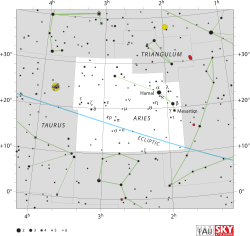Delta Arietis

Location of δ Arietis (circled) | |
| Observation data Epoch J2000 Equinox J2000 | |
|---|---|
| Constellation | Aries |
| Right ascension | 03h 11m 37.76465s[1] |
| Declination | +19° 43′ 36.0397″[1] |
| Apparent magnitude (V) | 4.349[2] |
| Characteristics | |
| Spectral type | K2 III[3] |
| U−B color index | +0.914[2] |
| B−V color index | +1.035[2] |
| R−I color index | 0.51 |
| Variable type | Suspected[4] |
| Astrometry | |
| Radial velocity (Rv) | 23.05 ± 0.20[3] km/s |
| Proper motion (μ) | RA: +153.33[1] mas/yr Dec.: –8.28[1] mas/yr |
| Parallax (π) | 19.22 ± 0.19[1] mas |
| Distance | 170 ± 2 ly (52.0 ± 0.5 pc) |
| Details | |
| Mass | 1.91[3] M☉ |
| Radius | 10.42 ± 0.97[5] R☉ |
| Luminosity | 45 ± 6[5] L☉ |
| Surface gravity (log g) | 2.93[5] cgs |
| Temperature | 4,810[5] K |
| Metallicity [Fe/H] | –0.03[5] dex |
| Rotational velocity (v sin i) | 4.3[6] km/s |
| Other designations | |
Delta Arietis (δ Ari, δ Arietis) is the Bayer designation for a star in the northern constellation of Aries. It has the traditional name Botein which is derived from the Arabic word for "belly". The apparent visual magnitude of this star is 4.35,[2] which is bright enough to be viewed with the naked eye. It has an annual parallax shift of 19.22 mas;[1] corresponding to a physical distance of approximately 170 light-years (52 parsecs) from Earth.
This is an evolved giant star with a stellar classification of K2 III.[3] It belongs to a population known as red clump giants, which means it is generating energy through the fusion of helium at its core.[8] With close to twice the mass of the Sun,[3] the outer envelope has expanded until it is around ten[5] times the Sun's radius. It shines with 45[5] times the Sun's luminosity at an effective temperature of 4,810 K,[5] giving it the orange-hued glow of a K-type star.[9] It is a suspected variable star that ranges in magnitude from 4.33 to 4.37.[4]
Etymology
The term Botein is derived from Al Bīrūnī's Al Buṭayn (ألبطين), the dual of Al Baṭn, the Belly. This is the name of star association consisting this star, along with ε Ari, ζ Ari, π Ari, and ρ3 Ari[10]
According to the catalogue of stars in the Technical Memorandum 33-507 - A Reduced Star Catalog Containing 537 Named Stars, Al Buṭain were the title for five stars :δ Ari as Botein, π Ari as Al Buṭain I, ρ3 Ari as Al Buṭain II, ε Ari as Al Buṭain III dan ζ Ari as Al Buṭain IV[11]
In the catalogue of stars in the Calendarium of Al Achsasi Al Mouakket, this star was designated Nir al Botain, which was translated into Latin as Lucida Ventris, meaning the brightest of the belly.[12]
In Chinese, 天陰 (Tiān Yīn), meaning Yin Force, refers to an asterism consisting of δ Arietis, 63 Arietis, ζ Arietis, τ Arietis and 65 Arietis.[13] Consequently, δ Arietis itself is known as 天陰四 (Lóu Su sì, English: the Fourth Star of Yin Force.)[14]
References
- ↑ 1.0 1.1 1.2 1.3 1.4 1.5 van Leeuwen, F. (November 2007), "Validation of the new Hipparcos reduction", Astronomy and Astrophysics 474 (2): 653–664, arXiv:0708.1752, Bibcode:2007A&A...474..653V, doi:10.1051/0004-6361:20078357.
- ↑ 2.0 2.1 2.2 2.3 Jennens, P. A.; Helfer, H. L. (September 1975), "A new photometric metal abundance and luminosity calibration for field G and K giants.", Monthly Notices of the Royal Astronomical Society 172: 667–679, Bibcode:1975MNRAS.172..667J.
- ↑ 3.0 3.1 3.2 3.3 3.4 Hekker, S. et al. (August 2006), "Precise radial velocities of giant stars. I. Stable stars", Astronomy and Astrophysics 454 (3): 943–949, arXiv:astro-ph/0604502, Bibcode:2006A&A...454..943H, doi:10.1051/0004-6361:20064946.
- ↑ 4.0 4.1 Samus, N. N.; Durlevich, O. V.; Kazarovets, R. V., "NSV 01066", General Catalogue of Variable Stars, retrieved 2012-08-04.
- ↑ 5.0 5.1 5.2 5.3 5.4 5.5 5.6 5.7 Piau, L. et al. (February 2011), "Surface convection and red-giant radius measurements", Astronomy and Astrophysics 526: A100, arXiv:1010.3649, Bibcode:2011A&A...526A.100P, doi:10.1051/0004-6361/201014442.
- ↑ Massarotti, Alessandro et al. (January 2008), "Rotational and Radial Velocities for a Sample of 761 HIPPARCOS Giants and the Role of Binarity", The Astronomical Journal 135 (1): 209–231, Bibcode:2008AJ....135..209M, doi:10.1088/0004-6256/135/1/209.
- ↑ "del Ari -- Variable Star", SIMBAD Astronomical Database (Centre de Données astronomiques de Strasbourg), retrieved 2012-08-04.
- ↑ Puzeras, E. et al. (October 2010), "High-resolution spectroscopic study of red clump stars in the Galaxy: iron-group elements", Monthly Notices of the Royal Astronomical Society 408 (2): 1225–1232, arXiv:1006.3857, Bibcode:2010MNRAS.408.1225P, doi:10.1111/j.1365-2966.2010.17195.x.
- ↑ "The Colour of Stars", Australia Telescope, Outreach and Education (Commonwealth Scientific and Industrial Research Organisation), December 21, 2004, retrieved 2012-01-16
- ↑ Allen, R. H. (1963), Star Names: Their Lore and Meaning (Reprint ed.), New York: Dover Publications Inc, p. 83, ISBN 0-486-21079-0, retrieved 2010-12-12
- ↑ Jack W. Rhoads - Technical Memorandum 33-507-A Reduced Star Catalog Containing 537 Named Stars, Jet Propulsion Laboratory, California Institute of Technology; November 15, 1971
- ↑ Knobel, E. B. (June 1895). "Al Achsasi Al Mouakket, on a catalogue of stars in the Calendarium of Mohammad Al Achsasi Al Mouakket". Monthly Notices of the Royal Astronomical Society 55: 429. Bibcode:1895MNRAS..55..429K.
- ↑ (Chinese) 中國星座神話, written by 陳久金. Published by 台灣書房出版有限公司, 2005, ISBN 978-986-7332-25-7.
- ↑ (Chinese) 香港太空館 - 研究資源 - 亮星中英對照表, Hong Kong Space Museum. Accessed on line November 23, 2010.
External links
| ||||||||||||||||||||||||||